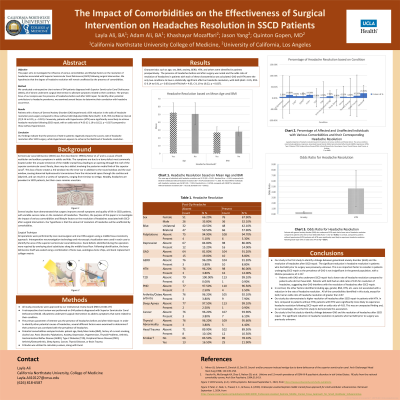Otology/Neurotology
(0940) Impact of Comorbidities on the Effectiveness of Surgical Intervention for Headache Resolution in Superior Canal Dehiscence Syndrome Patients
Monday, September 30, 2024
12:00 PM - 1:00 PM EDT

Disclosure(s):
Layla Ali, B.A., MD Candidate: No relevant relationships to disclose.
Introduction: The purpose of this paper is to investigate the impact of various comorbidities and lifestyle factors on the resolution of headaches associated with Superior Semicircular Canal Dehiscence (SSCD) after surgical intervention. We hypothesize that the amount of resolution of headaches will be unaffected by comorbidities.
Methods: A retrospective chart review was performed during June of 2023 on 344 patients diagnosed with Superior Semicircular Canal Dehiscence (SSCD). All patients underwent surgical intervention to address various symptoms that were related to their condition. The primary parameter of interest in this study was the presence of headaches before and after SSCD repair and how it related to comorbidities. Potential comorbidities analyzed include patient age, Body Mass Index (BMI), history of current smoking, palpitations, general anxiety disorder (GAD), depression, hypertension (HTN), thyroid problems, gastrointestinal reflux disease (GERD), type 2 diabetes (T2D), peripheral nerve disease (PND), arthritis/osteoarthritis, sleep apnea, cancer, thyroid abnormality, or head trauma.
Results: The majority of comorbidities analyzed were not related to headache reduction in this cohort. However, compared to patients without a history of GAD, patients with GAD were significantly less likely to experience headache resolution following surgery with an odds ratio of 0.35 (95% CI 0.14 to 0.91, p = 0.031). Furthermore, compared to patients without HTN, patients with HTN were significantly more likely to experience headache resolution following SSCD repair with an odds ratio of 4.65 (95% CI 1.19 to 18.22, p = 0.027).
Conclusions: Our findings suggest that the presence of GAD in patients reduces the success rate of headache resolution after SSCD surgery, whereas HTN improves the success rate of headache resolution.

Layla Ali, BA
Medical Student
California Northstate University College of Medicine
Arcadia, California, United States- QG
Quinton S. Gopen, MD
UCLA
Los Angeles, California, United States
